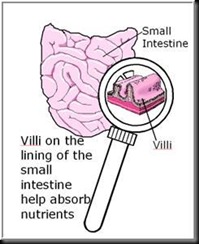Pizza, Ice-Cream, Pasta, Cookies Wow !!!! But halt. 
Celiac disease is a digestive disease that damages the small intestine and interferes with absorption of nutrients from food. People who have celiac disease cannot tolerate gluten, a protein in wheat, rye, and barley. Gluten is found mainly in foods but may also be found in everyday products such as medicines, vitamins, and lip balms.
When people with celiac disease eat foods or use products containing gluten, their immune system responds by damaging or destroying villi—the tiny, fingerlike protrusions lining the small intestine. Villi normally allow nutrients from food to be absorbed through the walls of the small intestine into the bloodstream. Without healthy villi, a person becomes malnourished, no matter how much food one eats.
Celiac disease is both a disease of malabsorption—meaning nutrients are not absorbed properly—and an abnormal immune reaction to gluten. Celiac disease is also known as celiac sprue, nontropical sprue, and gluten-sensitive enteropathy. Celiac disease is genetic, meaning it runs in families. Sometimes the disease is triggered—or  becomes active for the first time—after surgery, pregnancy, childbirth, viral infection, or severe emotional stress.
becomes active for the first time—after surgery, pregnancy, childbirth, viral infection, or severe emotional stress.
Symptoms:
Classic symptoms of disease include diarrhea, weight loss (or stunted growth in children), and fatigue.
- unexplained iron-deficiency anemia
- fatigue
- bone or joint pain
- arthritis
- bone loss or osteoporosis
- depression or anxiety
- tingling numbness in the hands and feet
- seizures
- missed menstrual periods
- infertility or recurrent miscarriage
- canker sores inside the mouth
- an itchy skin rash called dermatitis herpetiformis
People with celiac disease may have no symptoms but can still develop complications of the disease over time. Long-term complications include malnutrition—which can lead to anemia, osteoporosis, and miscarriage, among other problems—liver diseases, and cancers of the intestine.
Causes:
Celiac disease is caused by a reaction to gliadin, a gluten protein. Upon exposure to gliadin, the enzyme tissue transglutaminase modifies the protein, and the immune system cross-reacts with the bowel tissue, causing an inflammatory reaction. That leads to flattening of the lining of the small intestine (called villous atrophy). This interferes with the absorption of nutrients because the intestinal villi are responsible for absorption.
Diagnosis:
Blood Tests
People with celiac disease have higher than normal levels of certain autoantibodies—proteins that react against the body’s own cells or tissues—in their blood. To diagnose celiac disease, doctors will test blood for high levels of anti-tissue transglutaminase antibodies (tTGA) or anti-endomysium antibodies (EMA). If test results are negative but celiac disease is still suspected, additional blood tests may be needed.
Before being tested, one should continue to eat a diet that includes foods with gluten, such as breads and pastas. If a person stops eating foods with gluten before being tested, the results may be negative for celiac disease even if the disease is present.
Intestinal Biopsy
If blood tests and symptoms suggest celiac disease, a biopsy of the small intestine is performed to confirm the diagnosis. During the biopsy, the doctor removes tiny pieces of tissue from the small intestine to check for damage to the villi. To obtain the tissue sample, the doctor eases a long, thin tube called an endoscope through the patient’s mouth and stomach into the small intestine. The doctor then takes the samples using instruments passed through the endoscope.
Treatment:
The only treatment for celiac disease is a gluten-free diet. A gluten-free diet means not eating foods that contain wheat, rye, and barley. People with celiac disease can eat a well-balanced diet with a variety of foods. They can use potato, rice, soy, amaranth, quinoa, buckwheat, or bean flour instead of wheat flour. They can buy gluten-free bread, pasta, and other products from stores that carry organic foods. Plain” meat, fish, rice, fruits, and vegetables do not contain gluten.
The gluten-free diet requires a completely new approach to eating. Newly diagnosed people and their families may find support groups helpful as they learn to adjust to a new way of life. People with celiac disease must be cautious about what they buy for lunch at school or work, what they purchase at the grocery store, what they eat at restaurants or parties, and what they grab for a snack. Eating out can be a challenge. When in doubt about a menu item, a person with celiac disease should ask the waiter or chef about ingredients and preparation or if a gluten-free menu is available.
Gluten is also used in some medications. People with celiac disease should ask a pharmacist if prescribed medications contain wheat. Because gluten is sometimes used as an additive in unexpected products—such as lipstick and play dough reading product labels is important. If the ingredients are not listed on the label, the manufacturer should provide a list upon request. With practice, screening for gluten becomes second nature.

No comments:
Post a Comment